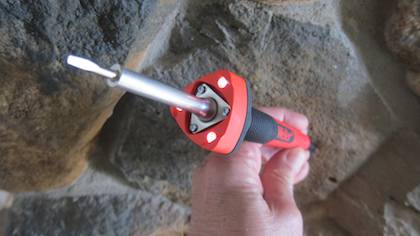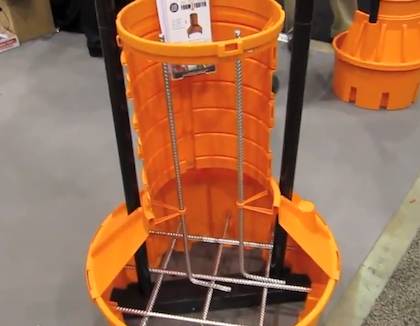May 1, 2013 AsktheBuilder Newsletter & Tips
Spring is here! Wowza! We're enjoying a string of gorgeous sunny weather here in New Hampshire with the temperatures kissing 70 F each day. When you're standing in the sun, it feels warmer than that. It's glorious and very welcome.
Yesterday, I took delivery of two gorgeous Simonton ProFinish windows that I'm going to be installing very soon. It's going to be an exciting project where I cut an opening in a solid wood-frame wall where there is currently no window. All you see now is just fiber cement siding on one side and drywall on the other.
Do you need to do the same thing but a job like that scares you? Do you feel you could do this with some guidance? I'll bet the answer is, "Yes Tim, I think I can do it with your help!"
Well, I'm going to be offering those tips and building secrets in a series of step-by-step videos that show you exactly what I'm thinking as I work and how I overcome the challenges of the project.
I'll be putting in a structural header over the window, so you can see how that's done. After that project is done, then we move on to putting in one of my classic Linear French Drains! This is what you use to stop water from leaking into basements and crawlspaces.
There's lots of work happening here in New Hampshire. How about at your house?
TIP OF THE WEEK - WATER AND CONCRETE
I've written countless articles about installing concrete. Perhaps you're going to work with this magical building material this spring or summer.
Yesterday I walked into a newer Post Office building in Tilton, NH. My guesstimate is the sidewalk that leads to the front door is less than five years old. The top surface of the concrete had spalled off exposing the ugly stones that give concrete its strength.
There are numerous possibilities as to what caused it to happen, but my money is on water. I'm pretty positive that freezing water caused the top finish to break away from the slab. I'd also wager that water was at the root of the problem, probably, when the concrete was being poured and finished.
Keep in mind that the Portland cement in concrete is the only thing holding the sand and stones in the mix together. If you dilute this cement, concrete loses its strength and is highly susceptible to the pressure caused by expanding ice crystals in concrete.
You can dilute the cement in the upper surface of the concrete if you add water to the concrete as you trowel it, or if you trowel in the bleed water that floats to the surface in between bull floating and troweling.
All you need to know is that you don't need to add water to concrete to finish it if you know what you're doing. Concrete that's incredibly stiff, some with a slump as low as 1 inch, can be finished without added water. Granted you may need the help of a vibratory machine, but understand there's enough water in the mix to achieve a stone-free finish.
SOLDERING IRON
I received a few soldering irons the other day. They're made by Weller.

Soldering irons are the perfect tool to help you make permanent connections when splicing wires or doing other projects that involve solder. I'm a huge fan of soldering copper or tin flashings up on roofs. You can achieve leak-proof joints that last over 100 years with solder.
I just used my old soldering iron a few weeks ago to solder small transistors and other parts onto a circuit board for a tiny ham radio I'm building.
These new soldering irons come with LED lights to help illuminate what you're working on. That's a good idea as you need to see what you're doing.
When working with soldering irons, you need to keep them away from anything that can be hurt by heat. They can set paper, cardboard, clothing, rags, etc. on fire in seconds. The metal tips are HOT, but they look innocent because they're not glowing red or have a flame showing. Be careful!
NEW HAMPSHIRE FREE SEMINAR
I'm going to offer a FREE home improvement clinic here in central New Hampshire on May 11, 2103. If you live in the area and want to stop by, I'd love to see you.
There are going to be all sorts of great door prizes. You can stop by and ask any home improvement question you like, and I'll do my best to answer it.
I'll be at the Funspot Bingo Hall at 579 Endicott Street N. on Route 3, one mile north of the historic Weirs Beach, NH. The clinic starts at 9:30 a.m. and runs till 11:00 a.m.
BUILDING A DECK? OR???
If you're building a deck or any other structure where you need to place a vertical support column on a concrete pier, you might have a number of questions:
- How do I pour the pier?
- What kind of form should I use?
- Does it need reinforcing steel?
- How do I cut and bend the steel?
- How do I connect the column to the pier?
That's just a partial list of questions. Last summer, I had the pleasure of easily answering most of those questions by using a product that assembled with NO TOOLS.
I had to pour eight piers, and precisely place them, for my large shed. I used the Form Footer. It's an ingenious plastic form that snaps together and comes with the needed one-half-inch steel bars already cut and pre-bent!
I had seen this marvelous invention months before at a trade show. Watch the video I shot of the Form Footer at the trade show.
If you don't use this product, your challenge is to pour a footer on one day, then you have to purchase a cardboard tube that will then hold the vertical concrete. Wait till you try to position this cardboard tube and support it so it doesn't move! Hah, good luck with that. Then you have to splice the steel rods from the footer to the column and get those positioned properly. You'll be cursing for sure by this time.
The beauty of the Form Footer is that you just place it on level compact ground and get it in the right position. The precut steel SNAPS into position inside the plastic form in seconds.
You then fill around it with dirt BEFORE you pour the concrete. The dirt and soil hold it in positions so it's level and plumb while you pour the concrete. You can assemble the form, place it in the hole, and pour the concrete within 30 minutes. What a great time and labor-saving idea!!!
If you're a new subscriber to this newsletter you probably don't know my policy about promoting products. I generally only promote things I think are great products AND I use them at my own home. That's important!!!
Well, I can tell you I used eight of the Form Footers and only wish they had been invented back when I was building every day. They're a dream product. It's absolutely a game changer, and I could see that when I walked down the aisle at the trade show.
If you purchase Form Footer products from this newsletter, I do get a very small commission. There's nothing wrong with that, especially since it's a win - win - win. You're the first winner, because you get a superlative product that will produce a great pier for your project. How's that for alliteration?
I have a short series of videos about Positioning Concrete Piers.
If you want to see a series of videos showing how to work with the Form Footer Pier Forms and discover some other ninja pier-building tricks, check out this video series:
INTERNET SALES TAX
Do you purchase lots of stuff online? Are you aware there's a movement that's trying to establish a nationwide sales tax on Internet sales?
I just want you to be aware that if this happens, you'll be directly affected. Prices of items will go up to take care of the administration of the tax. If you don't want an Internet sales tax, you have to let those that create such laws how you feel. It's that simple.
More Tips Next Week!

